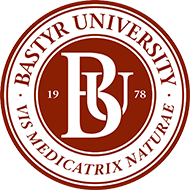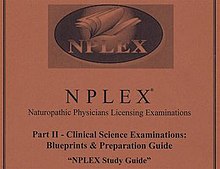
Naturopathy, or naturopathic medicine, is a form of alternative medicine. A wide array of pseudoscientific practices branded as "natural", "non-invasive", or promoting "self-healing" are employed by its practitioners, who are known as naturopaths. Difficult to generalize, these treatments range from outright quackery, like homeopathy, to widely accepted practices like certain forms of psychotherapy. The ideology and methods of naturopathy are based on vitalism and folk medicine rather than evidence-based medicine, although practitioners may use techniques supported by evidence.

Bastyr University is a private alternative medicine university with campuses in Kenmore, Washington, and San Diego, California. Programs include naturopathy, acupuncture, Traditional Asian medicine, nutrition, herbal medicine, ayurvedic medicine, psychology, and midwifery.

Doctor of Medicine is a medical degree, the meaning of which varies between different jurisdictions. In the United States, and some other countries, the M.D. denotes a professional degree. This generally arose because many in 18th-century medical professions trained in Scotland, which used the M.D. degree nomenclature. In England, however, Bachelor of Medicine, Bachelor of Surgery was used and eventually in the 19th century became the standard in Scotland too. Thus, in the United Kingdom, Ireland and other countries, the M.D. is a research doctorate, honorary doctorate or applied clinical degree restricted to those who already hold a professional degree (Bachelor's/Master's/Doctoral) in medicine. In those countries, the equivalent professional degree to the North American, and some others use of M.D., is still typically titled Bachelor of Medicine, Bachelor of Surgery (M.B.B.S.).
A medical school is a tertiary educational institution, or part of such an institution, that teaches medicine, and awards a professional degree for physicians. Such medical degrees include the Bachelor of Medicine, Bachelor of Surgery, Master of Medicine, Doctor of Medicine (MD), or Doctor of Osteopathic Medicine (DO). Many medical schools offer additional degrees, such as a Doctor of Philosophy (PhD), master's degree (MSc) or other post-secondary education.
The United States Medical Licensing Examination (USMLE) is a three-step examination program for medical licensure in the United States sponsored by the Federation of State Medical Boards (FSMB) and the National Board of Medical Examiners (NBME). Physicians with a Doctor of Medicine (MD) degree are required to pass the USMLE for medical licensure. However, those with a Doctor of Osteopathic Medicine degree (DO) are required to take the COMLEX-USA (COMLEX) exams.
A medical degree is a professional degree admitted to those who have passed coursework in the fields of medicine and/or surgery from an accredited medical school. Obtaining a degree in medicine allows for the recipient to continue on into specialty training with the end goal of securing a license to practice within their respective jurisdiction. Medical graduates may also pursue non-clinical careers including those in basic research and positions within the healthcare industry. A worldwide study conducted in 2011 indicated on average: 64 university exams, 130 series exams, and 174 assignments are completed over the course of 5.5 years. As a baseline, students need greater than an 85% in prerequisite courses to enroll for the aptitude test in these degree programs.
Step 2 Clinical Skills of the United States Medical Licensing Examination (USMLE) was an exam administered to medical students/graduates who wish to become licensed physicians in the U.S. It is similar to the COMLEX-USA Level 2-PE exam, taken by osteopathic medical students/graduates who seek licensure as physicians in the U.S. For US medical students, the exam fee is $1,300. For medical students at non-US medical schools, the tests cost is higher—currently $1,535. These fees do not include costs associated with travel and lodging to take the test. Historically, US students have taken Step 2 CS late in their senior year, prior to graduation. However, now that more residency programs require students to record a passing score, many US medical schools recommend students take Step 2 CS in the fall of their senior year.
The USMLE Step 1 is the first part of the United States Medical Licensing Examination. It aims to assess whether medical school students or graduates can apply important concepts of the foundational sciences fundamental to the practice of medicine. US medical students who wish to seek licensure to practice medicine in the US typically take Step 1 at the end of the second year of medical school. Graduates of international medical schools must also take Step 1 if they want to practice in the US. Graduates from international medical schools must apply through ECFMG, and the registration fee is $915. For 2020, the NBME registration fee for the test is $645, with additional charges for applicants who choose a testing region outside the United States or Canada.
The USMLE-Step 2-CK is the nine-hour-long multiple-choice portion of the second part of the United States Medical Licensure Examination. It assesses clinical knowledge through a traditional, multiple-choice examination. In contrast to the USMLE Step 1, the focus is much more on clinical application of medical knowledge. It assesses the ability to apply medical knowledge, skills, and understanding of clinical science essential for the provision of patient care under supervision. The USMLE Step 2 is generally taken during the 4th year of medical school by U.S. medical students.
The Comprehensive Osteopathic Medical Licensing Examination of the United States (COMLEX-USA) is a series of three osteopathic medical licensing examinations administered by the National Board of Osteopathic Medical Examiners (NBOME) similar to the United States Medical Licensing Examination (USMLE). COMLEX-USA is the most common pathway by which osteopathic physicians (D.Os) apply for medical licensure, and is accepted in all 50 states. The 3-digit standard scores of COMLEX-USA Level 1, Level 2- Cognitive Evaluation (CE), and Level 3 have a range of 9-999 and a mean of 500. Most candidates score between 250 and 800. 400 is the minimum passing score for COMLEX-USA Levels 1 and 2; 350 for COMLEX-USA Level 3. It was announced on January 24, 2022 that the COMLEX-USA Level 1 examination will be moving from a 3-digit numeric score to solely pass/fail beginning on May 10, 2022.
In health care, a simulated patient (SP), also known as a standardized patient, sample patient, or patient instructor, is an individual trained to act as a real patient in order to simulate a set of symptoms or problems. Simulated patients have been successfully utilized for education, evaluation of health care professionals, as well as basic, applied, and translational medical research.
An international medical graduate (IMG), earlier known as a foreign medical graduate (FMG), is a physician who has graduated from a medical school outside of the country where he or she intends to practice. The term non-local medical graduate may be similarly used in countries with distinct licensing regions within them. Generally, the medical school of graduation is one listed in the World Directory of Medical Schools (WDOM) as accredited by the Foundation for Advancement of International Medical Education and Research or the World Health Organization.
Most physicians in the United States hold either the Doctor of Medicine degree (MD) or the Doctor of Osteopathic Medicine degree (DO). Institutions awarding the MD are accredited by the Liaison Committee on Medical Education (LCME). Institutions awarding the DO are accredited by the Commission on Osteopathic College Accreditation (COCA). The World Directory of Medical Schools lists both LCME accredited MD programs and COCA accredited DO programs as US medical schools. Foreign-trained osteopaths do not hold DO degrees and are not recognized as physicians in the United States or in other jurisdictions.
Doctor of Osteopathic Medicine is a medical degree conferred by the 38 osteopathic medical schools in the United States. DO and Doctor of Medicine (MD) degrees are equivalent: a DO graduate may become licensed as a physician or surgeon and thus have full medical and surgical practicing rights in all 50 US states. As of 2021, there were 168,701 osteopathic physicians and medical students in DO programs across the United States. Osteopathic medicine emerged historically from osteopathy, but has become a distinct profession.
Step 3 is the final exam in the USMLE series of examinations. It is part of the licensing requirements for Doctors of Medicine (M.D.), including international medical graduates aiming to practice medicine in the United States. Generally, it is a pre-requisite of the majority of the state licensing boards.

The Canadian College of Naturopathic Medicine (CCNM) is a private not-for-profit institution with two campus locations, the CCNM - Toronto Campus in Toronto, Ontario, Canada and the CCNM - Boucher Campus in New Westminster, British Columbia, Canada.
The National Board of Medical Examiners (NBME), founded in 1915, is a United States non-profit which develops and manages assessments of health care professionals. Known for its role in developing the United States Medical Licensing Examination (USMLE) in partnership with the Federation of State Medical Boards (FSMB), USMLE examinations for medical students and residents are used by medical licensing authorities in the U.S. to help determine qualifications to grant and recognize medical licenses. NBME also creates assessments and materials that are used by medical students, medical educators, practicing physicians, and for state testing of physicians already holding licenses.

Kimball C. Atwood IV is an American medical doctor and researcher from Newton, Massachusetts. He is retired as an assistant clinical professor at Tufts University School of Medicine and anesthesiologist at Newton-Wellesley Hospital.

Britt Marie Hermes is an American former naturopathic doctor who became a critic of naturopathy and alternative medicine. She is the author of a blog, Naturopathic Diaries, where she writes about being trained and having practiced as a licensed naturopath and about the problems with naturopaths as medical practitioners.

The standard entry-to-practice degree in modern evidence-based medicine in India is the Bachelor of Medicine and Bachelor of Surgery (MBBS). Alternative systems of Medicine in India are Ayurveda (BAMS), Unani (BUMS), Siddha(BSMS), Homeopathy (BHMS). M.B.B.S. a credential earned upon completion of a five-and-a-half-year undergraduate program. The curriculum is divided into one year of preclinical studies in general science subjects and three and a half years of paraclinical and clinical studies, followed by a one-year clinical internship. Before beginning the internship, students are required to pass several examinations, the final one of which is conducted in two parts. Postgraduate education in medical specialties typically takes 3 additional years of study after the MBBS and concludes with the award of a Master of Surgery or Doctor of Medicine(MD). Postgraduate diplomas in medical specialities may also be awarded upon the completion of two-year training programs.








